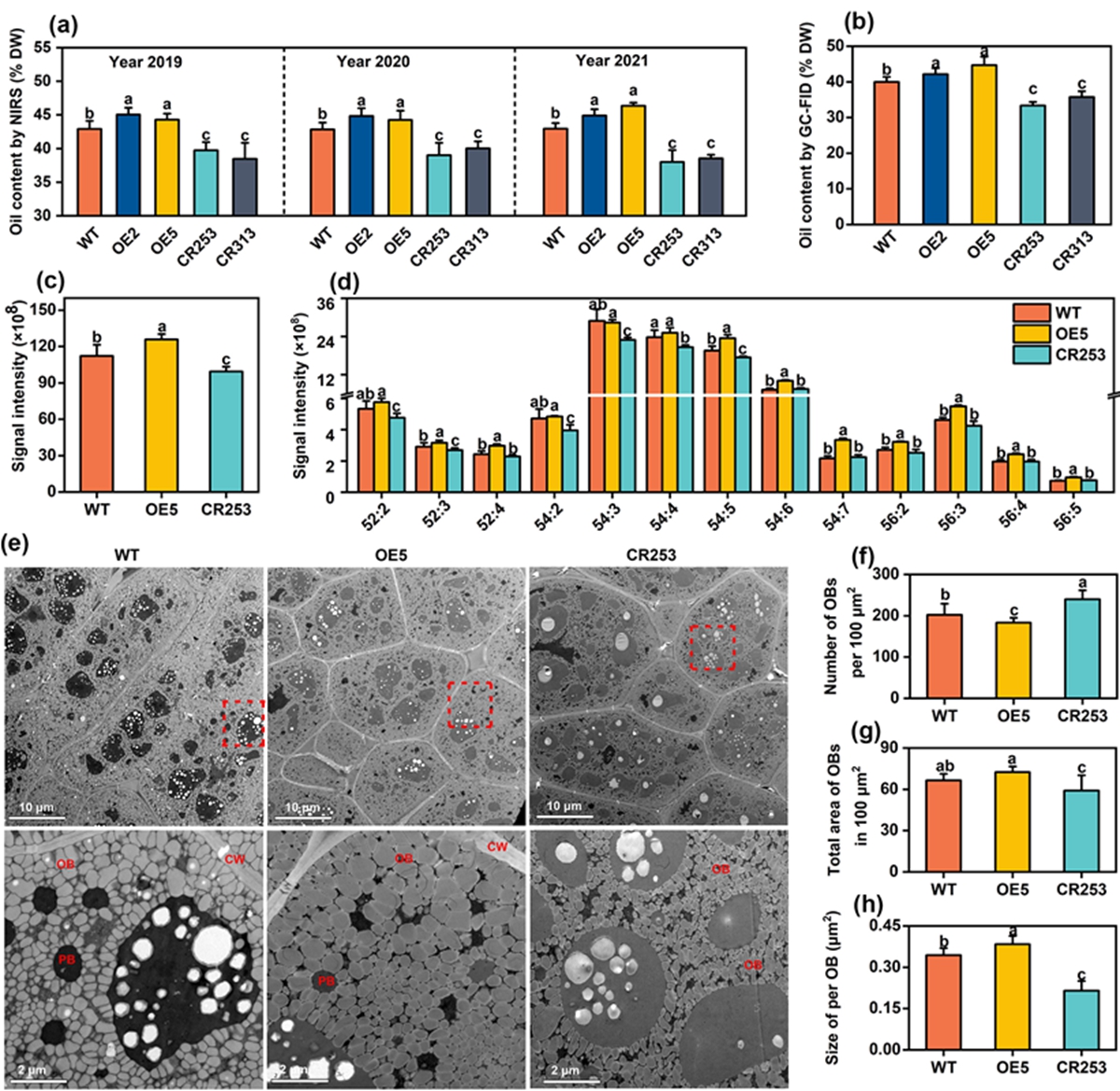南湖新闻网讯(通讯员 唐珊)近日,我校油菜团队在Journal of Advanced Research和Plant Biotechnology Journal分别发表题为“BnaPPT1 is essential for chloroplast development and seed oil accumulation in Brassica napus”和“Pyruvate transporter BnaBASS2 impacts seed oil accumulation in Brassica napus”的研究论文。研究结果表明磷酸烯醇式丙酮酸转运蛋白BnaPPT1和丙酮酸转运蛋白BnaBASS2在油菜籽粒油脂积累方面起着重要作用。
植物细胞内,磷酸烯醇式丙酮酸盐/磷酸盐转运蛋白(PPT)和胆汁酸-钠转运蛋白(BASS2)分别将糖酵解途径代谢物磷酸烯醇式丙酮酸和丙酮酸从细胞质转运到质体,从而满足质体中的脂肪酸合成和其他代谢活动。植物中,PPT和BASS2对质体中脂肪酸合成以及种子中油脂积累的影响尚不清楚。发表在Journal of Advanced Research的研究以甘蓝型油菜为研究对象,发现了叶绿体膜定位的BnaPPT1在叶片膜脂合成和叶绿体发育中发挥着重要作用,并影响叶片光合作用。研究结果表明,将BnaPPT1敲除后,油菜生长缓慢,叶片呈淡黄色。叶片色素测定和叶绿体超微结构观察显示,突变体中叶绿素及叶绿素前体含量均显著降低,叶绿体的基粒片层变薄,形成更多更小的叶绿体和淀粉粒。基于液相色谱串联质谱法(LC-MS/MS)的脂质代谢物分析显示,突变体中叶绿体膜脂主要成分MGDG、DGDG和PG含量分别降低67.8%、68.5%和16.4%。此外,BnaPPT1影响了油菜种子的糖酵解途径和脂质代谢途径,在种子油脂合成中发挥着重要作用。BnaPPT1突变体种子含油量降低了2.2 ~ 9.1%,而过表达BnaPPT1显著提高了种子含油量2.1 ~ 3.3%。
发表在Plant Biotechnology Journal的研究创建了BnaA05.BASS2的过表达油菜材料,通过基因编辑创建了BnaA05.BASS2 and BnaC04.BASS2-1的油菜双突变体。油菜BASS2双突变体的株高、单株角果数、粒重和单株产量等均显著下降,而过表达植株的主要农艺性状基本没有受到影响。连续3年对含油量表型分析表明,突变体的籽粒含油量降低了2.8 ~ 5.0%,而过表达BnaA05.BASS2显著提高了籽粒含油量1.4 ~ 3.4%。BnaBASS2过表达显著提高了参与油脂合成和油体形成的多个基因的表达水平,促进了籽粒中的油脂积累。基于液相色谱串联质谱法的代谢组分析表明敲除BnaA05.BASS2 and BnaC04.BASS2-1可以显著降低叶绿体中丙酮酸盐的含量,证明了BnaBASS2负责向质体转运丙酮酸盐。同时,BnaBASS2可以显著影响油菜种子叶绿体中糖酵解、脂肪酸合成和能量相关代谢产物的含量。综上所述,BnaPPT1和BnaBASS2在质体代谢物转运方面发挥着重要的作用,可以显著影响油菜籽粒中的油脂积累。

BnaBASS2影响油菜种子油脂积累
我校油菜遗传改良团队的唐珊博士为两篇论文的第一作者,郭亮教授为通讯作者,鲁少平副研究员和姚璇副教授也参与了该研究的指导。两项研究得到了国家自然科学基金、湖北洪山实验室重大项目、华中农业大学-中国农业科学院深圳农业基因组研究所联合项目、中国博士后科学基金和湖北省博士后创新岗位资助。
审核人:鲁少平
【英文摘要】
Introduction
Phosphoenolpyruvate/phosphate translocator (PPT) transports phosphoenolpyruvate from the cytosol into the plastid for fatty acid (FA) and other metabolites biosynthesis.
Objectives
This study investigated PPTs’ functions in plant growth and seed oil biosynthesis in oilseed crop Brassica napus.
Methods
We created over-expression and mutant material of BnaPPT1. The plant development, oil content, lipids, metabolites and ultrastructure of seeds were compared to evaluate the gene function.
Results
The plastid membrane localized BnaPPT1 was found to be required for normal growth of B. napus. The plants grew slower with yellowish leaves in BnaA08.PPT1 and BnaC08.PPT1 double mutant plants. The results of chloroplast ultrastructural observation and lipid analysis show that BnaPPT1 plays an essential role in membrane lipid synthesis and chloroplast development in leaves, thereby affecting photosynthesis. Moreover, the analysis of primary metabolites and lipids in developing seeds showed that BnaPPT1 could impact seed glycolytic metabolism and lipid level. Knockout of BnaA08.PPT1 and BnaC08.PPT1 resulted in decreasing of the seed oil content by 2.2 to 9.1%, while overexpression of BnaC08.PPT1 significantly promoted the seed oil content by 2.1 to 3.3%.
Conclusion
Our results suggest that BnaPPT1 is necessary for plant chloroplast development, and it plays an important role in maintaining plant growth and promoting seed oil accumulation in B. napus.
论文链接:https://www.sciencedirect.com/science/article/pii/S2090123222001631
【英文摘要】
BILE ACID: SODIUM SYMPORTER FAMILY PROTEIN 2 (BASS2) is a sodium dependent pyruvate transporter which transports pyruvate from cytosol into plastid in plants. In this study, we investigated the function of chloroplast envelope membrane-localized BnaBASS2 in seed metabolism and seed oil accumulation of Brassica napus (B. napus). Four BASS2 genes were identified in the genome of B. napus. BnaA05.BASS2 was overexpressed while BnaA05.BASS2 and BnaC04.BASS2-1 were mutated by CRISPR in B. napus. Metabolite analysis revealed that manipulation of BnaBASS2 caused significant changes in glycolysis-, fatty acid synthesis- and energy-related metabolites in the chloroplasts of 31 day-after-flowering (DAF) seeds. The analysis of fatty acids and lipids in developing seeds showed that BnaBASS2 could affect lipid metabolism and oil accumulation in developing seeds. Moreover, overexpression (OE) of BnaA05.BASS2 could promote the expression level of multiple genes involved in the synthesis of oil and formation of oil body during seed development. Disruption of BnaA05.BASS2 and BnaC04.BASS2-1 resulted in decreasing of the seed oil content (SOC) by 2.8% to 5.0%, while OE of BnaA05.BASS2 significantly promoted the SOC by 1.4% to 3.4%. Together, our results suggest that BnaBASS2 is a potential target gene for breeding B. napus with high SOC.
论文链接:https://onlinelibrary.wiley.com/doi/abs/10.1111/pbi.13922

